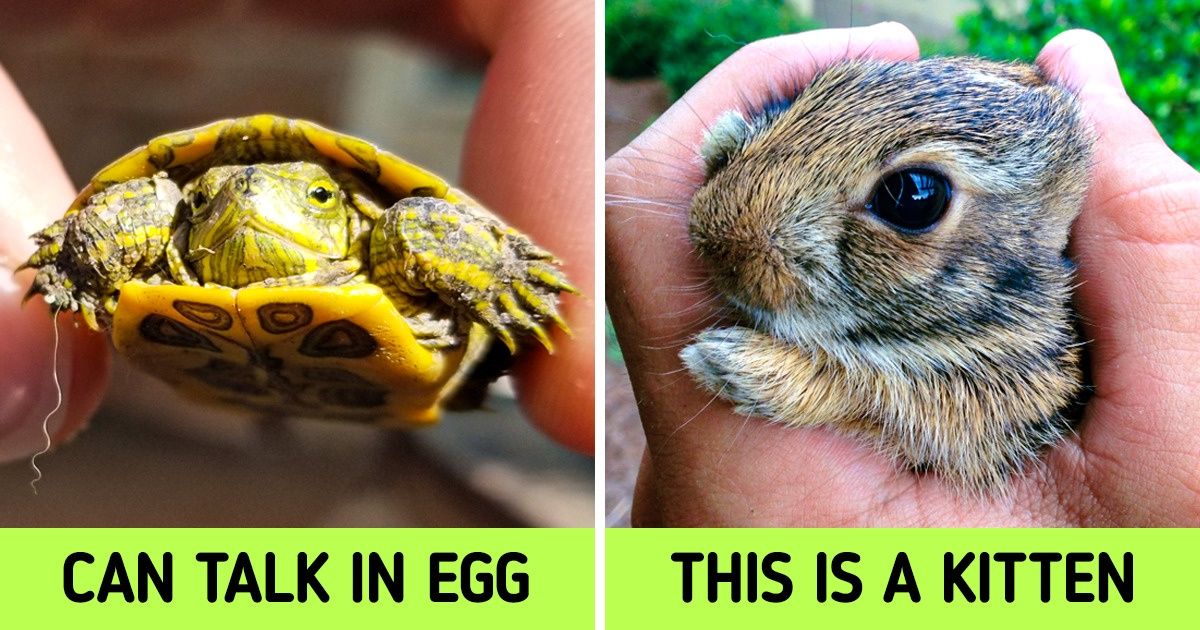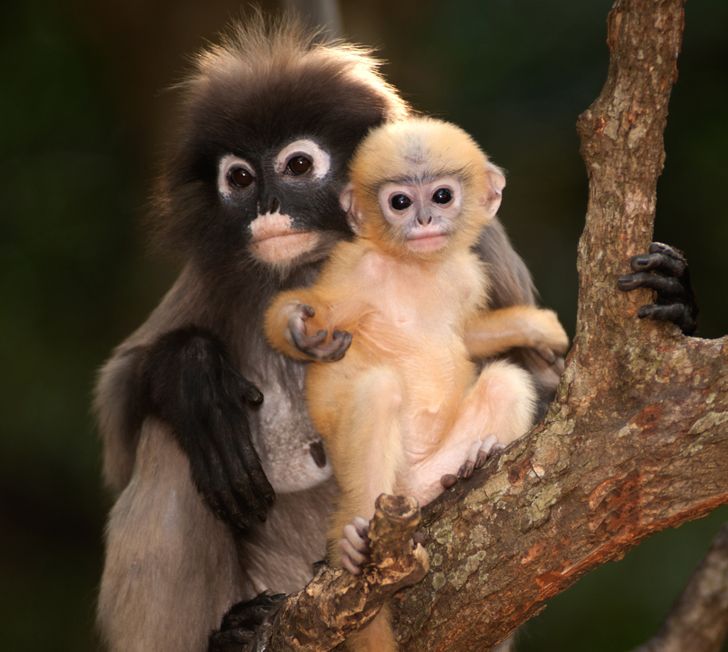Thanks
20 Baby Animal Facts That Make Us Want to Thank Mother Earth for All the Smiles

A study has concluded that looking at endearing animal pictures can improve focus. And if we add in baby animal facts to the mix, it’s double the joy. Like a baby elephant who has no idea about what to do with that “arm” on its face, or a pygmy marmoset infant “talking” just like babies do — even the size of a panda bear cub at birth — we just can’t get enough.
Bright Side has gotten lost in the world of itty-bitty baby animals and brings you the sweetest pictures with the most aww-worthy facts to go along with them.
1. Baby rabbits are also called kittens.
We know that a baby of a cat is called a kitten. But a baby rabbit is also a kitten, and so is a baby beaver. So cats don’t have a monopoly on the term.
2. When born, a giraffe calf falls 6 feet to the ground.
Human babies are lucky: they’re born into waiting hands with plenty of detailed medical procedures that involve snipping the umbilical cord and coaxing the baby to take its first breath. Giraffe calves, on the contrary, fall up to 6 feet (2 meters) to the ground. This breaks the umbilical cord and gives them the shock and incentive to take a breath.
3. Elephant calves don’t know how to use their trunks.
Elephant calves are endearingly clumsy at birth, much like most of the other large land mammal babies. Other than learning how to stand, walk, and do other elephant stuff, they also have to learn how to use their trunks.
4. Parrot chicks have their very own name for life.
According to a study, parrot parents name their babies with different call signs. While it may not be John or Jim, there is a different birdsong for each baby. And research indicates that the acoustic identity stays for life.
5. Baby orangutans take 8 years to wean from their moms.
Human babies are exclusively breastfed for 6 months, or rather, that’s the ideal, according to the World Health Organization. But orangutan infants can breastfeed for up to 8 years in the wild.
6. Dolphin calves can drink milk underwater.
Dolphins and whales are aquatic mammals. Not only do they give birth to little ones underwater, but they also breastfeed underwater. And this happens because of the dolphin mamas’ inverted nipples and voluntary milk ejections.
7. Koala joeys are the size of a jelly bean at birth.
Koala bears are the very symbol of maternal love in the animal world. Like kangaroos, koalas are marsupials and have a special stomach pouch for the baby to sit in, like nature’s incubator. When koala joeys are born, they are the size of a jelly bean, roughly 2 cm in length, and they weigh just a gram.
8. A pygmy marmoset infant babbles just like a human baby.
Pygmy marmosets are the world’s smallest monkeys, with an adult’s weight reaching just a little over 100 grams. The babies and infants are way tinier, but what truly sets them apart is their “baby talk.” Just like human infants, pygmy marmoset infants babble.
9. Reptile hatchlings have an egg tooth to break the shell.
Oviparous, or egg-laying mammals, start their life by breaking out of the egg with a little help from nature. Reptiles, birds, and other animals that hatch have a little egg tooth. It’s a protuberance at the end of their snouts or on top of the beak to help them break out of the egg. Later, the egg tooth is reabsorbed in the body.
10. Otter pups are so fluffy, they can’t drown.
Sea otter pups are so fluffy at birth with a dense coat of fur, they can’t drown. Plus, unlike freshwater otters who give birth in dens on land, sea otters give birth in the water, so it’s a good thing that otter pups are naturally buoyant.
11. Flamingo chicks are born gray, like the ugly duckling.
In the Danish fairy tale by Hans Christian Anderson, the ugly duckling turns out to be a swan. But looking at the dull gray of a flamingo chick, it could just as easily have been a flamingo. In fact, that beautiful shade of pink that flamingoes have comes from their steady diet of algae and brine shrimp. The chicks are actually whitish-gray.
12. Puppies can be born as identical twins.
It’s taken the world a while to recognize this fact, but even puppies can be born as identical twins. While it’s common for pups of the same litter to look alike, identical pups are startlingly the same.
13. Panda bear cubs are born the size of a stick of butter.
Panda moms birth cubs that are 1/900th their size, weighing just 90-130 grams — just like your average stick of butter — only pinker, wigglier, and blind as a bat. This makes for one of nature’s most diverse size differences between a newborn and an adult.
14. Blue whale calves gain about 10 pounds per hour.
15. Newborn fawns have camouflage.
Fawns are often born at the height of predator season and are naturally vulnerable to attack. As natural protection, they are born with many white camouflage spots on their body with some mottling, which basically looks like bits of light and shadows in the foliage. This helps a fawn evade a predator’s eyes.
16. Baby langurs are often a different color from their parents.
Human babies resemble their parents in skin color, but langur babies are born a different color. For instance, the babies of the Dusky Leaf Langur (seen above), the Red Langur, and the François’ Langur are all different in color from the adults. This is to help the females of the group easily spot the infants and take care of them.
17. Rhinoceros calves don’t have a horn at birth.
The rhinoceros horn is made up of keratin, the same thing our hair and fingernails are made of. But when a rhinoceros calf is born, it doesn’t have a horn. A stub appears between 1 and 2 months. From then on, the juvenile begins to grow the horn. The name rhinoceros itself means “nose horn.”
18. Macaque infants play with anything and everything.
Primate infants are playful, and the macaque baby is no different. Playing with sticks and stones comes naturally, but the Japanese macaques are a bit different. Also referred to as snow monkeys, they are not averse to a snowball fight or some playtime.
19. Platypus puggles hatch from eggs.
Not only is the duck-billed platypus an egg-laying mammal, but their babies are also called puggles. The only other mammal that lays eggs is the echidna, and its babies are called puggles as well.
20. Baby turtles can communicate from within the egg.
Baby turtles can begin communicating from within the egg, one study alleges. The researchers put a microphone to the eggs and were surprised to hear noises. Apparently, this helps the baby turtles to plan their hatching and eventual migration to the water together.
Which of these baby animal facts made you stand up and applaud nature? Do you know of any other amazing facts? Please share them with us in the comment section below.
Comments
Related Reads
20+ Extraordinary People Who Have Their Own Way of Doing Things

15+ Animals Whose Charisma Brings a Sparkle to Humans’ Lives

16 People Whose Middle Name Is “Surprise”

13 Family Conflicts That Sound Straight Out of a Soap Opera

12 Stories That Had More Drama Than a Season Finale

12 Stories That Prove Little Acts of Kindness Never Stay Little

I Refused to Trust My Stepson After His Lies—He’s No Longer Welcome in My House

I Refused to Give Up My Extra Plane Seat to a Kid — Things Escalated Quickly

I Refuse to Be Treated Like the Family Nanny—And My Mom Chose Her Boyfriend Over Me

My DIL Shut Me Out of the Family Vacation but I Didn’t Hold My Tongue

12 Unseen Sacrifices Moms Make to Put Their Kids First

I Refused to Have My MIL on Another Trip If She Won’t Babysit—Her Slapback Was Brutal












